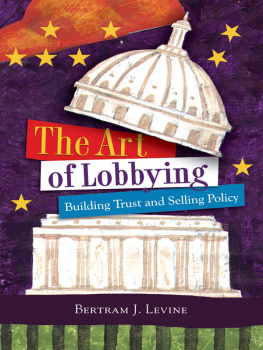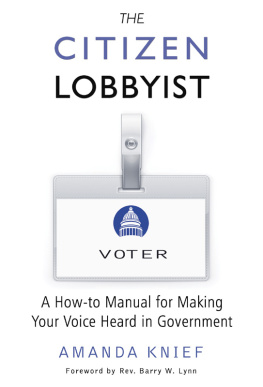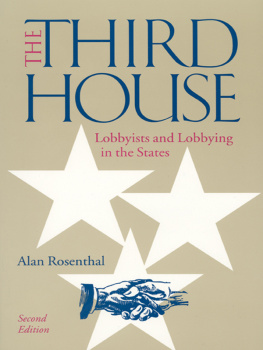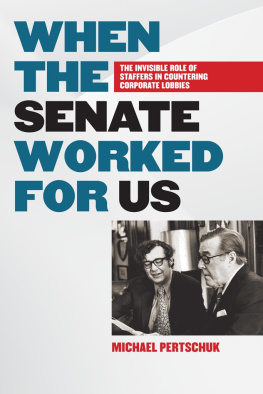CQ Press
2300 N Street, NW, Suite 800
Washington, DC 20037
Phone: 202-729-1900; toll-free, 1-866-4CQ-PRESS (1-866-427-7737)
Web: www.cqpress.com
Copyright 2009 by CQ Press, a division of SAGE. CQ Press is a registered trademark of Congressional Quarterly Inc.
All rights reserved. No part of this publication may be reproduced or transmitted in any form or by any means, electronic or mechanical, including photocopy, recording, or any information storage and retrieval system, without permission in writing from the publisher.
Cover design: Silverander Communications, Santa Barbara, California
Composition: Alliance Publishing, Glen Rock, New Jersey

The paper used in this publication exceeds the requirements of the American National Standard for Information SciencesPermanence of Paper for Printed Library Materials, ANSI Z39.48-1992.
Printed and bound in the United States of America
12 11 10 09 08 1 2 3 4 5
Library of Congress Cataloging-in-Publication Data
Levine, Bertram J.
The art of lobbying: building trust and selling policy / Bertram J. Levine.
p. cm.
Includes bibliographical references and index.
ISBN 978-0-87289-462-4 (pbk.: alk. paper) 1. LobbyingUnited States. I. Title.
JK1118.L48 2009
328.73078dc22
2008045115
Preface
Lobbyists are sometimes called the fourth branch of government or the third house of Congress. Many lobbyists likely would consider these designations to indicate an elevation in their statusand a well-earned one at that. They are pleased. Other people, on the contrary, may see an ill-gotten usurpation of authority. They are not so pleased; in fact, they are horrified.
Whatever ones view, this much is clear: Lobbyists are indispensable players in the business of national policymaking. Whether representing a business, an industry, a nonprofit institution, a public interest group, or a faith-based organization, lobbyists are the means by which the private sector participates in the give-and-take of lawmaking in Washington, D.C. When viewed as special interest pleaders, they are likened to interlopers, trespassers upon a public domain rightfully reserved for duly empowered public officials. When seen as citizens representatives performing an essential function in a complex world, they not so problematically can be regarded as the fourth branch or a third house.
The distinction is important, especially in the aftermath of the lobbying scandals of the early 2000s involving Jack Abramoff and Rep. Tom DeLay, R-Texas, when indignant members of Congress tried to outbid each other in regulating lobbyistlawmaker relationships. Their indignation is understandable, but indignation alone does not beget intelligent responsefar from it. Overzealous remediation, designed more for public consumption than for optimal policy results, is the all too frequent outcome of bidding contests among tough-guy legislators. Congress has responded to the Abramoff scandal by ratcheting down on permissible social contact between lobbyists and lawmakers and by slowing the revolving door between government service and private-sector positions.a These new laws may at first seem to be reasonable responses to corrupt behavior, but are they? Or are they unnecessary barriers to open and trusting exchanges of information and ideas, the sort of exchanges that promote fully informed deliberation?
What is both troublesome and ironic is that each new limitation on lobbyistlawmaker interaction signals diminished confidence by Congress in its own integrity. Lobbyists cannot answer yea or nay to roll call votes, offer amendments, insert language into committee reports, speak on the floor of either chamber in Congress, question witnesses at hearings, or gavel a markup session to order. At any given time only 535 peoplethe members of Congresscan do these things. Lobbyists may influence how and when members cast their votes, and how members participate in legislative activity. But influence is one thing; authority to do these things is another. Members have this authority; lobbyists do not. Thus lobbyists can wine and dine, contribute funds, and raise as much political money for the candidates of their choice as they are able to do, but unless members are amenable to being swayed by these or other forms of largesse, no undue influence will come of the lobbyists efforts. The member who claims otherwise might as well claim the devil made me do it.
Academic journals and lay publications bulge with articles on this subject. Is there really such a devil at work? Maybe so, but this book will not contribute to the bulge in any important way.b It is well conceded that money plays a role in gaining access to members of Congress and that it likely plays a role in how some members vote some of the time. But, according to current and former lawmakers and staff, much else, other than campaign money, goes into forging a successful lobbyistmember relationship. Among the other elses are a manifest concern for the common good, sensitivity, intelligence, and good old-fashioned savvy.
This book is a qualitative examination of the elses.c It is designed to discover what members of Congress and their staffers consider, consciously or intuitively, when deciding which lobbyists they will hear, which arguments they will take seriously, and with whom they will establish ongoing relationships.
The primary research method for this book was one-on-one interviews that I conducted with sixty-five present and formermostly formerfederal policymakers and eight practicing lobbyists. (There will be more on the interviews in I provide some general guidance on what lobbyists should think about as they design their legislative strategies. As much as possible, however, I let the legislators and staff provide the insights.
Notwithstanding the obvious concerns about vested interests, personal bias, and false honor, it would be absurd to dismiss the observations of veteran policymakers with a simple Theyre all a bunch of crooks. They are not. Richard F. Fennos view that good public policy is among the three basic goals espoused by members of Congress remains accepted wisdom.1 Many hundreds of hours of conversation with the study cohort convinced me that Fenno was dead on.
The interviews were supplemented by what Fenno and Richard L. Hall call soaking and poking, or just hanging around. Hall explains the value of this research technique: If such an experience does not provide what normally gets labeled data, it certainly improves the ability of the researcher to do better in the (unscientific) social science enterprise of moving from results to interpretations. And, in the end, of course, the interpretations matter.2
One such interpretation that came out of the interviews I conducted is this: With but a few exceptions there is little that resembles an absolute in the lobbying profession. There is no equation that provides the practitioner with a constant, predictable outcome. The work is too complex, too varied, and too personal for that. In addition, it is too situation-driven and too issue-dependent to be quantified. Thus the title of this book: Lobbying is not a science but an art. Moreover, it is an art within an artthe art of politics. And as in both the performance arts and the fine arts, the critics matter: The extent to which lobbyists succeed or fail, perform a positive or less admirable role in congressional deliberations, and are accepted or spurned on Capitol Hill is a function of what the ultimate critics, the policymakers, demand and valuenot more, not less.













 The paper used in this publication exceeds the requirements of the American National Standard for Information SciencesPermanence of Paper for Printed Library Materials, ANSI Z39.48-1992.
The paper used in this publication exceeds the requirements of the American National Standard for Information SciencesPermanence of Paper for Printed Library Materials, ANSI Z39.48-1992.